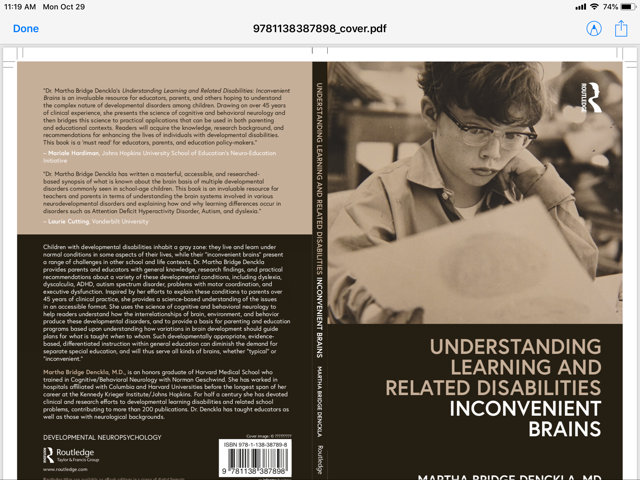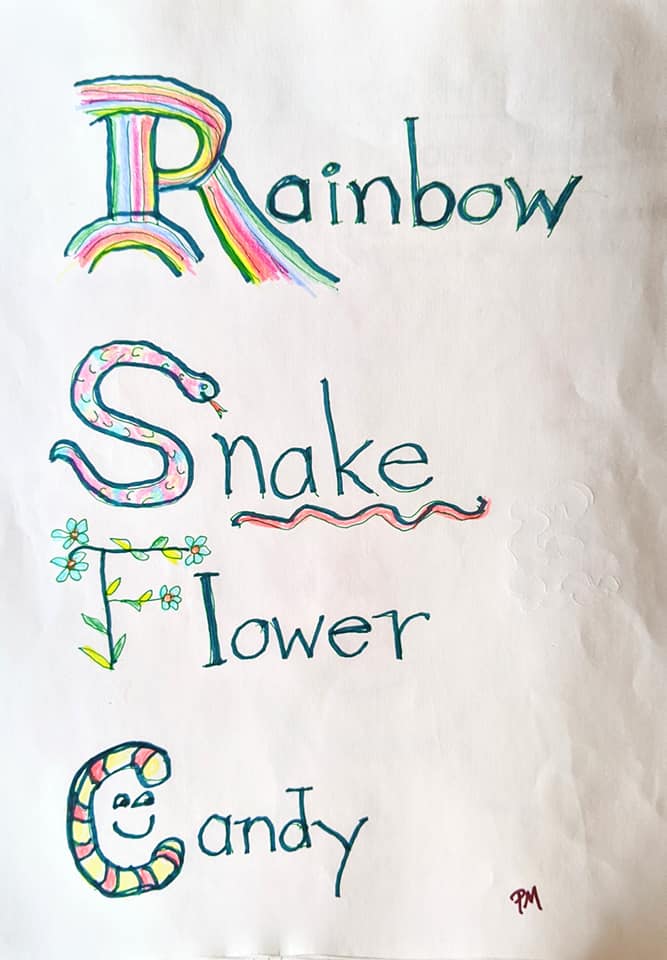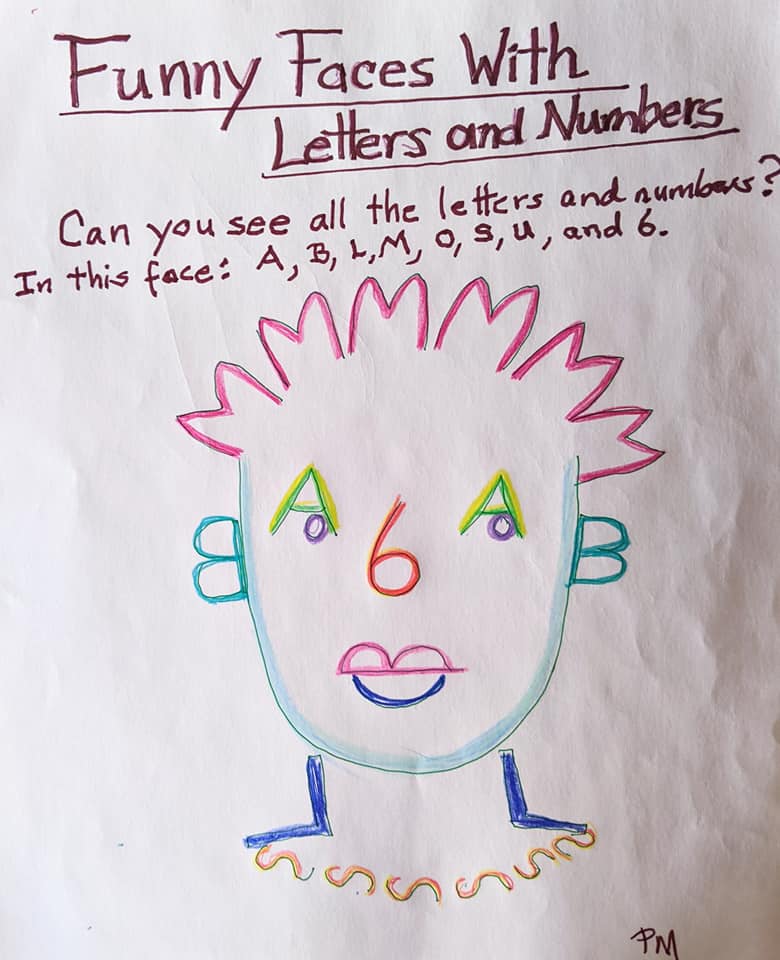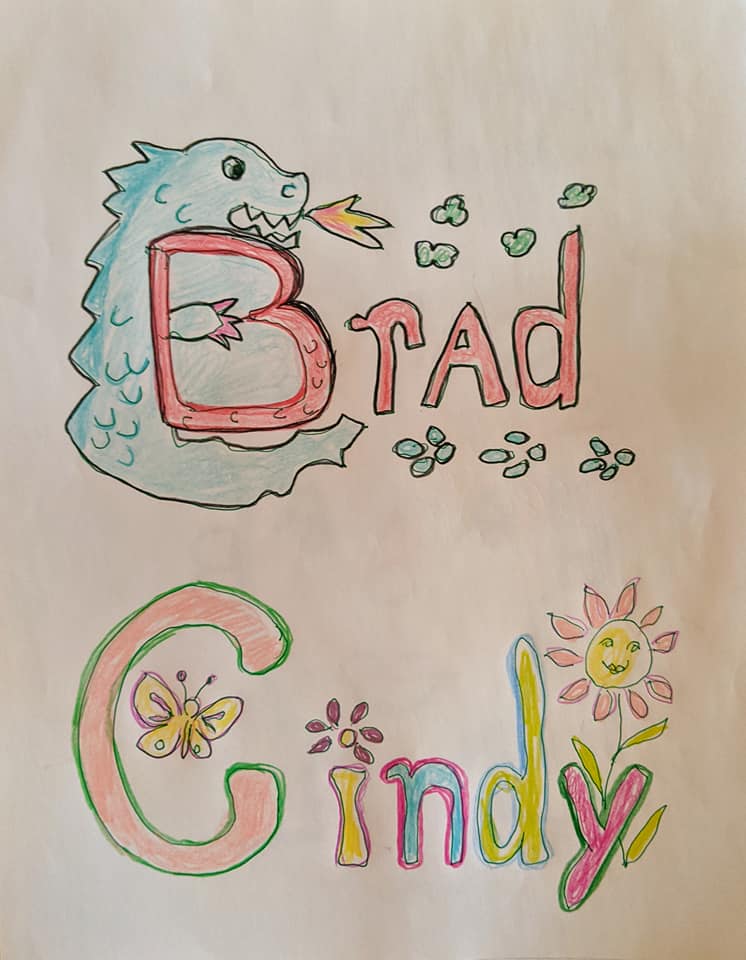It sounds like there’s a shortage of ideas to work with students with or without disabilities, especially students who don’t work well online, or need a break from it. So, I am starting this page and will add to it, if there’s interest, in days to come.
I welcome teachers and parents to add whatever they’d like to share, what works for you, or special resource pages or links.
Note: I am adding some valuable information that should be helpful to you if you are working on handwriting with your students.
I would like to thank Martha Bridge Denckla, Professor Emerita, Neurology, Johns Hopkins University School of Medicine. Martha contacted me to offer some valuable pointers on handwriting and is the author of the following book:
She says:
I wish to add my expertise on the pencil grasp issue. See my book chapter on motor development for details.
The main point is that immature connections underlie “incorrect” pencil grasp in young children more often than “don’t know how” and until myelination allows proper distal finger control won’t work for PRINTING. Hand movements can work for CURSIVE, which is one more reason we should offer cursive to Kg or first graders with “poor pencil grasp.”
This advice applies to all children because ages and developmental levels, not just disability states, influence handwriting.
She adds:
Being one of the vanishing group of people called “moderates,” this is the balance I advocate. Yes, teach cursive early (I love Jan Olson’s Handwriting without Tears”) on wide ruled paper, but also teach printing in what I call “Dr. Denckla’s Write Big program”( I could get private schools to do this when recommended from my small once a week clinic).
Write Big means a vertical surface with some writing implement that allows the arm to control the movements of letter formation. This assuages our teacher and parent anxiety lest we lose the kinesthetic reinforcement afforded by printing letters that are closer than cursive to the “look” of what is printed in books; but then we watch the child carefully for development of a proper distal finger control seen( perhaps in art class) and follow the lead of the child’s observed development to progress to sitting down and using a paper and pencil printing method( still with appropriately wide ruled paper, of course.)
What we already know empirically is that the brain’s visual cortex is fantastic at scaling from big to small; we already provide gradually more closely spaced ruled writing paper as children grow from Kg to 12, recalling that in the era before everyone was “writing” on computer, we had “college ruled” notebooks and loose leaf paper!
So I would simultaneously do a bit of cursive and do write big (I shouldn’t capitalize the words, it isn’t copyrighted or formal in any way, it’s just my clinical extrapolation from research) for printing each day. The immature child is not “excused” or left out of the daily printing instruction, just does it on a vertical surface, using the arm, while standing up! (The standing may make him or her, more often “him,” the envy of several others.)
Handwriting
Teachers don’t always focus on handwriting because of other skills they are made to address. The focus on technology has sometimes pushed handwriting out of the picture. So, helping students, especially students with reading or writing (dysgraphia) disabilities, become better at handwriting at home, might be a beneficial exercise at this time.
Teachers struggle to understand what students mean when they turn in sloppy papers. Even if students misspell words, it’s much easier to see the breakdown of their errors and help them correct their papers, when letters are neatly printed or written in cursive.
***Don’t push a child to write if they have difficulty holding a pencil or if they are too young.
Holding a pencil.
This may seem strange, but many students don’t know how to hold a pencil! My husband teaches college students and remarks about the many strange ways he has observed students holding pencils and pens in a cramped and uncomfortable manner.
The pencil should be held between the thumb and middle finger with the index finger riding the pencil. The pencil should be grasped above the sharpened point. Pencil grippers are helpful, or some tape or a rubber band wrapped around the pencil can help with gripping.
Younger children work better with larger pencils.
Here’s a great Wiki explanation.
Here’s a quick trick called pinch and flip.
Paper positioning.
Paper isn’t usually slanted for printing. Tilt writing paper at an angle about 60 degrees from vertical, to the left for right-handed children, and the right, for left-handed children (Lerner, p. 192-193). Children should hold paper with their free hand. Hold paper in place with tape if necessary.
Cursive Handwriting
Schools don’t always teach cursive, but it could be helpful for children, but especially for children with dyslexia or reading disabilities. Some children might find copying cursive letters relaxing. Practicing can be quieting and give parents a needed break.
It has been known for years that cursive might be easier than print for children with learning disabilities because of the rhythmic continuity. It helps students who make reversals, which are common for students who print. (Lerner, p. 190).
Start with capitals and move to small letters and then connect letters to words. Give the child some sample letters to copy. Once they master some letters, add short words.
- Tracing paper or plastic overlay can help children practice writing.
- Copying partial letters for children to complete can help children copy.
Printing
If a child is better at printing, and they don’t like cursive, or it’s too difficult, help them practice spacing and making neat letters.
Practice
Look for ways to work with children on handwriting at home. Encourage them to use what they learn every day. If they are unable to use handwriting, the computer keyboard is acceptable.
Studies by Gene Ouellette, an associate professor of psychology at Mount Allison University, and Monique Sénéchal, a psychology professor at Carleton University, found that invented spelling is important for reading. They call it the “missing piece.” With writing practice spelling slowly improves.
- Encourage children to write for fifteen or twenty minutes every day. Don’t judge.
- If a child is too young for writing, let them dictate a story.
- Make available old magazines, colored pencils, markers, so students can illustrate their stories.
- Help them with topics if they ask.
- Choose a writing piece they’re proud of, correct it. Let them rewrite the piece correctly knowing how proud you are of their work. Show it off. Make a book!
Handwriting works on fine motor skills, visual-motor coordination, visual memory, spatial relationship, focusing, reading, spelling, self-confidence and, of course, writing letters and words. Helping children with or without disabilities improve their handwriting is a worthy goal during this difficult time. It will help when they return to school and forever.
Project Ideas
From teacher pro Pamela Michaels:
My comment has to do with Art activities that could reinforce learning how to make and remember letters. So, here are 4 easy ideas that most children would understand; they could work as integrated Arts lessons. Basic ideas behind these:
Having fun with the letters – no right or wrong!
- Reinforcement of recognizing and creating basic shapes
- Attaching meaning
- Practice with hand-eye coordination, fine motor skills
- Using imagination
Those are the basics – some pragmatic uses of decorative lettering could be making small signs, nameplates, posters, writing short poems and decorating them.
These are a Primary version of Illuminated text. For older students one could show examples of some of the historic versions, or show how Fonts evolved, and have the students create their own fonts.
Years ago, another Teacher and I team-taught a class called Art and Language to High School Students with Learning Disabilities, and by the time we got them, they absolutely hated anything to do with Reading and Writing. Our intent was to help them see other ways of considering those skills. Teachers can adapt them and come up with their own variations.
Examples
Reference
Lerner, J.W. (1971). Children with Learning Disabilities: Theories, Diagnosis, and Teaching Strategies. Boston: Houghton Mifflin Company.






MY hand hurt watching the demonstrations on pencil holding although I did like the putting a ball in the palm to keep the hand more relaxed. However, I have found that holding the pencil so close to the tip encourages cramping. If you move your finger back to roughly an inch from the tip, the hand remains more relaxed and is less likely to cramp as quickly if a lot of writing is done. the fingers are able to move more freely. Pencil grips and larger pencils may help as well but again I would push the grip back a bit.
Nice suggestion. I’m with you. Thanks for reading and commenting.
I would suggest another skill-based activity that gets very short shrift, despite the big push for STEM classes, yet is the very focal point of all engineering: Measurement! (metrics and/or imperial))
Most homes have simple measuring tools: ruler/yard stick/tape measure (linear distance); bathroom scale (weight/force) ; measuring cup (liquid volume/ solid volume by displacement).
Teachers could provide measuring challenges using standardized objects. For example: Measure the height and diameter of a D-cell battery; use water displacement to determine its volume.
Measure the circumference of a basketball. Measure your squeezing strength in pounds.
I have some measurement based engineering/construction activities that I can provide for free to any parent or teacher who might be interested. Just need an email. These are hands-on physical challenges that use simple, readily available materials.
Thanks, Rick! Parents, if interested send me your email and I will pass it on to Rick.
Stay well.
I have always wondered why some kids do not write good enough for someone to read it. Often it will be incredibly neat and well-formed, but so small that I had trouble reading it even before my vision began to go south a bit. Other times it looks like the student just did not really care or was trying, like a friend of mine, to be deliberately deceptive (his method for making essays look longer was to insert squiggles in his writing that could not be read, reasoning that the teacher might simply despair of spending the time on him and give him a good grade).
I have also found that there are some children who have trouble getting their minds to slow down in order to get it on paper.
I have seen that tiny writing too. Not exactly sure what’s behind it. It looks painful.
Students with attention difficulties write hurriedly and tend not to focus. Sometimes I’ve seen students who slow down enough to do beautiful art work. Is it more visually pleasing? Do they care more about it?
I do think when you actually work with students and help them focus on their writing they will try more to do a good job. When they start to see their writing improve they usually care more about it.
Some students also have fine motor control difficulties where they simply cannot get the letters right. Keyboarding is usually the alternative. .
My thanks to Diane Ravitch.
https://dianeravitch.net/2020/03/29/nancy-bailey-how-to-help-students-improve-their-reading-and-writing/?fbclid=IwAR1uREsjkbZ8ZgGmBAFcxlsJ2z6HY6VkPtkUTC9zu0TWcEz6R42lmYLqxNY
Thanks for mention8ng Diane Ravitch. Are you familiar with these two other articles, by her, on some handwrot8ng curriculum concerns?
http://pulse.ncpolicywatch.org/2013/04/24/cursive-writing-bill-linked-to-zaner-bloser/
https://dianeravitch.net/2013/04/19/handwriting-expert-to-nc-and-sc-dont-mandate-cursive-writing/
Thanks for mentioning Diane Ravitch. Are you familiar with these two other articles, by her, on some handwriting curriculum concerns?
http://pulse.ncpolicywatch.org/2013/04/24/cursive-writing-bill-linked-to-zaner-bloser/
https://dianeravitch.net/2013/04/19/handwriting-expert-to-nc-and-sc-dont-mandate-cursive-writing/
I received all of my K-12 education in Germany in German public schools in the 1950’s.
Beginning in Kindergarten, we were taught to write in cursive, starting with forming loops and circular letters: o, a, c, e, extending to loop letters: b, d, l, t,….words were presented, in time, by looping letters together to form words and basic sentences. Printing was taught later, almost like calligraphy. Legibility was taught, practiced and reviewed daily with assignment completion. Must time was spent daily and yearly. We started with pencils and were required to write with fountain pens during the end of first grade as we progressed. I never remembered a struggle with writing skills. I’m sure there were some children who needed extra support.
Proof my generation almost wrote with precision and uniformity – comparing the handwritings of my friends and family through letters and recipes.
I found this video on cursive instruction in France to be quite insightful, especially how they fuse dance and movement into writing instruction.
https://youtu.be/QLF-f1RiFS0
LH, thanks for the video….
watching it took me back to my childhood, although, not to France.
This was exactly how we were taught in Germany. Integration of large fluid motions transferred to fluid fine motor skills. I also remember listening to music while we practiced looping letters together.
Later, as a teacher in the US, I could not understand why fluidity of forming letters was not introduced until cursive was taught – if it was EVER TAUGHT. Millions of children were never taught cursive in the US. Testing and tons of often useless facts for testing pushed aside many life skills so necessary for all of us. Being able to read documents, signatures, letters, diaries, archives and recipes….are still important.
What a shame!
I fully support teaching handwriting is necessary! I think it is a great omission that schools have shifted their emphasis to other skills related to technology.
Teaching proper paper positioning and pencil holding plays a big role in the success of mastering handwriting skills, including for children with dyslexia and other disabilities. This is a very informative article. Thank you!
Thanks, Amanda. You make excellent points. However, I deleted the advertisement. I try not to showcase any group profiting from instruction.
It wasn’t an advertisement. But I understand your position! Thank you.
Would you be willing to review/evaluate my book READ CURSIVE FAST?
If so, I can yet you a free PDF for review/evaluations purposes.
Publisher’s page: https://nationalautismresources.com/read-cursive-fast/
Amazon’s page: https://www.amazon.com/Read-Cursive-Fast-Historical-Documents/dp/1735935808/ref=sr_1_3
Book’s web-site: ReadCursiveFast.com
Hi Kate,
I’m sorry. I don’t think I could do it justice.
Good luck!
Nancy
Thanks for your honesty. However, I’m curious to know why you don’t think you could do it justice. Understanding your thoughts on the matter would probably help me reach out to others.
By the way, thanks, immensely for the excellent and important tips on using a vertical surface to write. Re hand movement issues & printing — there are clear forms of pr8nting which work better, for hand move e te than the conventional ones … or s9 it seems to me. I’d value your “take” on the various programs /models at these links: https://archive.nytimes.com/www.nytimes.com/interactive/2009/09/04/opinion/20090908_opart.html?_r=0, HandwritingSuccess.com, https://sites.google.com/view/briem/handwriting?authuser=0, BFHhandwriting.com, and italic-handwriting.org .